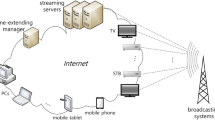Abstract
Databases were introduced to remove redundancy from conventional file systems and encouragesharing, which resulted in update anomalies when information was modified. With presentations (movies) sharing clips (sequence of frames), continuous display becomes challenging as well. Continuous display requires the system to retrieve the information with no disruptions or delays (hiccups) once a display is initiated. To ensure a continuous display using a multi-disk hardware platform, a video object is striped into subobjects. The system enforces a regular schedule on retrieval of each subobject by controlling the placement of the subobjects across the disks. Now if different presentations share subobjects, each presentation will enforce its own restrictions on the placement of the data, resulting in an irregular schedule. We investigate approaches to render a schedule regular for two alternative display paradigms: Demand and Data driven.
Similar content being viewed by others
References
Allen JF (1983) Maintaining knowledge about temporal intervals. Commun ACM 26(11):832–843
Anderson D, Homsy G (1991) A continuous media I/O server and its synchronization. IEEE Commputer 24(10):51–57
Berson S, Ghandeharizadeh S, Muntz R, Ju X (1994) Staggered striping in multimedia information systems. Proceedings of the ACM SIGMOD International Conference on Management of Data, ACM Press, Minneapolis, Minnesota, pp 79–90
Chen HJ, Little T (1993) Physical storage organizations for time-dependent multimedia data. Proceedings of the Foundations of Data Organization and Algorithms (FODO) Conference, Chicago, Illinois. Springer, Berlin Heidelberg New York, pp 19–34
Dipert B, Herbert L (1993) Flash memory goes mainstream. IEEE Spectrum 11:48–52
Fox EA (1991) Advances in interactive digital mmultimedia systems. IEEE Computer 24(10):9–21
Ghandeharizadeh S, Ramos L, Asad Z, Qureshi W (1991) Object placement in parallel hypermedia systems. Proceedings of the International Conference on Very Large Databases, Morgan Kaufmann, Barcelona, Spain, pp 243–254
Ghandeharizadeh S, Kim H, Shahabi C (1994) On Configuring a single disk continuous media server. Technical Report USC-CS-94-590, University of Southern California, Los Angeles, Calif
Ghandeharizadeh S, Kim H, Shahabi C (1994) Display of continuous media with multi-zone magnetic disks. Technical Report USC-CS-94592, University of Southern California, Los Angeles, Calif
Haskell B (1989) International Standards activities in image data compression. Proceedings of Scientific Data Compression Workshop. NASA Conference Pub 3025, NASA Office of Management, Scientific and technical information division, USA, pp 439–449
Prince B, Norwood R, Hartigan J, Vogley W (1992) Synchronous dynamic RAM. IEEE Spectrum 29(10):44–47
Rangan P, Vin H (1993) Efficient storage techniques for digital continuous media. IEEE Trans Knowledge Data Eng 5:564–573
Rangan P, Vin H, Ramanathan S (1992) Designing an on-demand multimedia service. IEEE Commun Magazine 30(7):56–64
Reddy ALN, Wyllie JC (1994) I/O issues in a multimedia system. IEEE Comput Magazine 27(3):69–74
Tobagi FA, Pang J, Baird R, Gang M (1993) Streaming RAID — a disk array management system for video flies. First ACM Conference on Multimedia, ACM Press, Anaheim, Calif, pp 393–400
Wallace S (1994) Managing mass storage. Byte 19(3):78–88
Author information
Authors and Affiliations
Rights and permissions
About this article
Cite this article
Shahabi, C., Ghandeharizadeh, S. Continuous display of presentations sharing clips. Multimedia Systems 3, 76–90 (1995). https://doi.org/10.1007/BF01219803
Issue Date:
DOI: https://doi.org/10.1007/BF01219803




